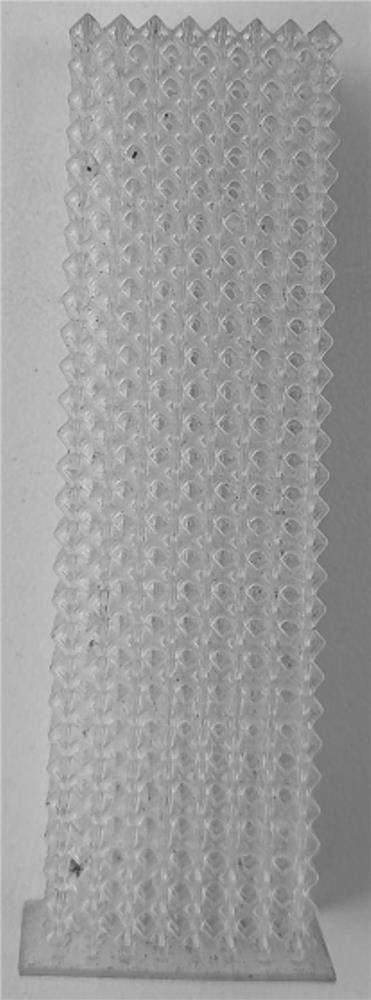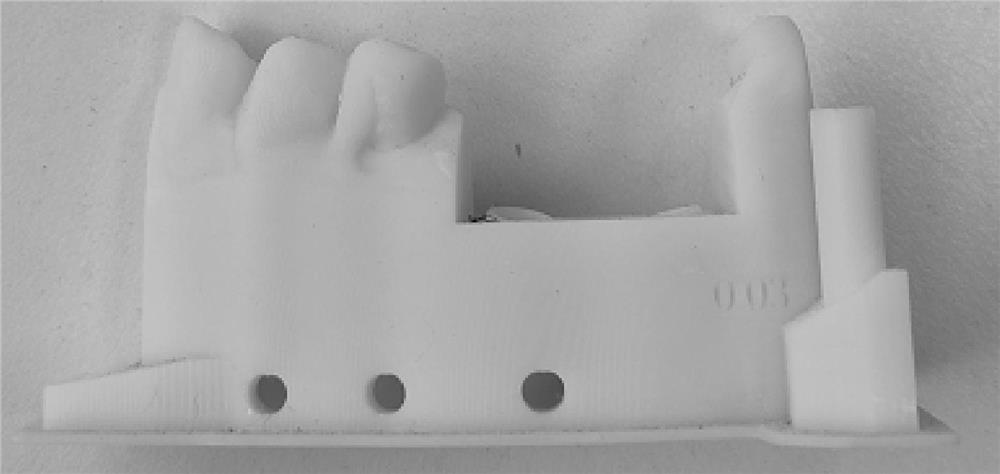Amino polymerization inhibition modified heat-conducting particle and preparation method thereof
A thermally conductive particle and modified technology, applied in the field of additive manufacturing to reduce surface cracking
- Summary
- Abstract
- Description
- Claims
- Application Information
AI Technical Summary
Problems solved by technology
Method used
Image
Examples
Embodiment 1
[0055] The epoxy resin-based liquid photosensitive resin is 3D printed by using a PET light-transmitting release film, and the epoxy resin-based liquid photosensitive resin includes the following components in parts by weight:
[0056] 30 parts epoxy resin
[0057] Vinyl ether monomer 5 parts
[0058] Heterocyclic monomer 5 parts
[0059] Initiator 1 part
[0060] Pigment 0.1 part.
[0061] Amino polymerization-inhibited modified heat-conducting particles are added to the epoxy resin-based liquid photosensitive resin, and the mass concentration of the amino-inhibited polymerization-modified heat-conducted particles in the epoxy resin-based liquid photosensitive resin is 1%, and then the three-dimensional printing to be printed The CAD model of the object is sliced, and the thickness of the slice is 0.05mm. Finally, the printing platform is moved vertically upward at a speed of 200mm / h, and the 3D printed stereogram is obtained. figure 2 .
Embodiment 2
[0063] The epoxy resin-based liquid photosensitive resin is 3D printed by using a PET light-transmitting release film, and the epoxy resin-based liquid photosensitive resin includes the following components in parts by weight:
[0064] 50 parts of epoxy resin
[0065] Vinyl ether monomer 20 parts
[0066] Heterocyclic monomer 10 parts
[0067] Initiator 5 parts
[0068] 3 parts of paint.
[0069] Amino polymerization-inhibited modified heat-conducting particles are added to the epoxy resin-based liquid photosensitive resin, and the mass concentration of the amino-inhibited polymerization-modified heat-conducting particles in the epoxy resin-based liquid photosensitive resin is 1.5%, and then the three-dimensional printing to be printed The CAD model of the object is sliced, and the thickness of the slice is 0.025mm. Finally, the printing platform is moved vertically upward at a speed of 100mm / h, and the 3D printed stereogram is obtained. image 3 .
Embodiment 3
[0071] The epoxy resin-based liquid photosensitive resin is 3D printed by using FEP light-transmitting release film, and the epoxy resin-based liquid photosensitive resin includes the following components in parts by weight:
[0072] 40 parts epoxy resin
[0073] Vinyl ether monomer 10 parts
[0074] Heterocyclic monomer 8 parts
[0075] Initiator 3 parts
[0076] 1 part of paint.
[0077] Amino polymerization-inhibited modified heat-conducting particles are added to the epoxy resin-based liquid photosensitive resin, and the mass concentration of the amino-inhibited polymerization-modified heat-conducting particles in the epoxy resin-based liquid photosensitive resin is 1.5%, and then the three-dimensional printing to be printed The CAD model of the object is sliced, and the slice thickness is 0.1mm. Finally, the printing platform is moved vertically upwards at a speed of 300mm / h, and the 3D printed stereogram is obtained. Figure 4 .
PUM
| Property | Measurement | Unit |
|---|---|---|
| particle diameter | aaaaa | aaaaa |
| thickness | aaaaa | aaaaa |
Abstract
Description
Claims
Application Information
 Login to View More
Login to View More - R&D
- Intellectual Property
- Life Sciences
- Materials
- Tech Scout
- Unparalleled Data Quality
- Higher Quality Content
- 60% Fewer Hallucinations
Browse by: Latest US Patents, China's latest patents, Technical Efficacy Thesaurus, Application Domain, Technology Topic, Popular Technical Reports.
© 2025 PatSnap. All rights reserved.Legal|Privacy policy|Modern Slavery Act Transparency Statement|Sitemap|About US| Contact US: help@patsnap.com



